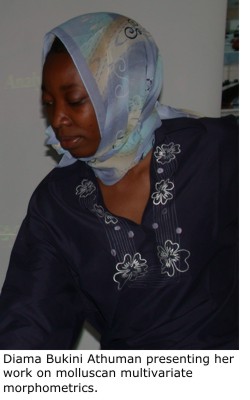 "Diama did a superb job of taking high-quality digital photos for data collection on shape differences in Lavigeria nassa. We were interested in testing for subtle changes in shell morphology incurred by the presence of trematode parasites, in addition testing for differences among sites, and between sexes. The collections work was done in collaboration with Ranjan Muthukrishnan, who was looking at the prevalence of parasites among sites. "Diama did a superb job of taking high-quality digital photos for data collection on shape differences in Lavigeria nassa. We were interested in testing for subtle changes in shell morphology incurred by the presence of trematode parasites, in addition testing for differences among sites, and between sexes. The collections work was done in collaboration with Ranjan Muthukrishnan, who was looking at the prevalence of parasites among sites.
"Twelve sites were sampled for 100 snails each. Photo documentation was done on 800 of these individuals (before the shell was broken to check for parasites and sex) and quantitative analysis was performed on a subset of approximately 40 indiv/site. Daima used TPSdig to generate landmark points on homologous points (guided by spiral sculpture on the shell), followed by PCA and CDA analysis of 21 distance variables that thoroughly describe the shell form.
"The intention is to follow this up with relative warp analyses of the same points. The preliminary report from this project is available on the Nyanza Project website." |